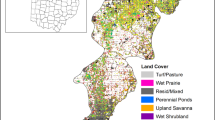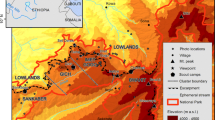Abstract
Historic landcover dynamics in a scrubby flatwoods (Tel-4) and scrub landscape (Happy Creek) on John F. Kennedy Space Center were measured using aerial images from 1943, 1951, 1958, 1969, 1979, and 1989. Landcover categories were mapped, digitized, geometrically registered, and overlaid in ARC/INFO. Both study sites have been influenced by various land use histories, including periods of range management, fire suppression, and fire management. Several analyses were performed to help understand the effects of past land management on the amount and spatial distribution of landcover within the study sites. A chi-squared analysis showed a significant difference between the frequency of landcover occurrence and management period. Markov chain models were used to project observed changes over a 100-year period; these showed current management practices being effective at Tel-4 (restoring historic landscape structure) and much less effective at Happy Creek. Documenting impacts of past management regimes on landcover has provided important insight into current landscape composition and will provide the basis for improving land management on Kennedy Space Center and elsewhere.
Similar content being viewed by others
References
Abrahamson, W.G. 1984a. Post-fire recovery of Florida Lake Wales Ridge vegetation. Am. J. Bot. 71: 9–21.
Abrahamson, W.G. 1984b. Species responses to fire on the Florida Lake Wales Ridge. Am. J. Bot. 71: 35–43.
Abrahamson, W.G. and Hartnett, D.C. 1990. Pine Flatwoods and Dry Prairies. In: Ecosystems of Florida. pp. 103–149. Edited by Myers, R.L. and J.J. Ewel, University of Central Florida Press, Orlando. 765 p.
Adrian, F.W., Lee, R.C., Jr., and Sasser, J.E. 1983. Upland management plan Merritt Island National Wildlife Refuge. USFWS/ MINWR. Titusville, Florida.
Aubreville, A. 1938. La foret coloniale: les fortes de lAfrique occidentale francaise. Ann. Acad. Sci. Coloniale Paris 9: 1–245.
Benson, B.J. and MacKenzie, M..D. 1995. Effects of sensor spatial resolution on landscape structure parameters. Land. Ecol. 10: 113–120.
Bergen, S. 1994. Characterization of fragmentation in Florida Scrub Communities. M.S. Thesis. Florida Institute of Technology, Melbourne, Florida. 71 pp.
Boyle, S. R. 1996 A landscape approach to Florida Scrub-Jay (Aphelocoma coerulescens) habitat use in Brevard County, Florida. M.S. Thesis, Florida Institute of Technology, Melbourne, Florida. 134 pp.
Bratton, S.M. and Miller, S.G. 1994. Historic field systems and the structure of maritime oak forest, Cumberland Island National Seashore, Georgia. Bull. Torrey Bot. Club 121: 1–12.
Breininger, D.R., Larson, V.L., Duncan, B.W., Smith, R.B., Oddy, D.M., and Goodchild, M.F. 1995. Landscape patterns of Florida Scrub Jay habitat use and demographic success. Cons. Biol. 9: 1442–1453.
Breininger, D.R., Larson, V.L., Schaub, R., Schmalzer, P.A., Duncan, B.W., Oddy, D.M., and Smith, R.B.. 1996. A conservation strategy for the Florida Scrub Jay on John F. Kennedy Space Center/Merritt Island National Wildlife Refuge: an initial scientific basis for recovery. NASA Technical Memorandum 111676. John F. Kennedy Space Center, Florida. 113 pp.
Breininger, D.R. and Schmalzer, P.A. 1990. Effects of fire and disturbance on plants and birds in a Florida oak/palmetto scrub community. Am. Midland Nat 123: 64–74.
Callaway, R.M. and Davis, F.W. 1993. Vegetation dynamics, fire, and the physical environment in coastal central California. Ecology 74: 1567–1578.
Clements, F.E. 1916. Plant Succession: An analysis of the development of vegetation. Carnegie Institute Publication 242, Washington, D.C. 512 pp.
Davison, K.L. and Bratton, S.P. 1986. The vegetation history of Canaveral National Seashore, Florida. CPSU Technical Report 22. U.S. National Park Service Cooperative Park Studies Unit, Institute of Ecology, University of Georgia, Athens. 75 pp.
Daubenmire, R.F. 1968. Plant communities: A textbook of plant synecology. Harper and Row, New York. 300 pp.
Duncan, B.W., Breininger, D.R., Schmalzer, P.A., and Larson, V.L. 1995. Validating a Florida Scrub Jay habitat suitability model, using demography data on Kennedy Space Center. Photogr. Eng. & Remote Sensing 61: 1361–1370.
Environmental Systems Research Institute, Inc., 1991. ARC/INFO command reference and users guides 6.0. The geographic information systems software, Redlands, California.
Environmental Systems Research Institute, Inc., 1994. Introducing Arcview, Arcview the geographic information system for everyone. Redlands, California.
Fernald, R.T. 1989. Coastal xeric scrub communities of the Treasure Coast Region, Florida. Nongame Wildlife Program Technical Report No. 6. Florida Game and Freshwater Fish Commission, Tallahassee. 113 pp.
Forman, R.T. and Godron, M. 1986. Landscape Ecology. John Wiley & Sons, Inc. New York. 619 pp.
Frelich, L.E. and Reich, P.B. 1995. Spatial patterns and succession in a Minnesota southern-boreal forest. Ecological Monographs 65: 325–346.
Frost, C.C. 1993. Presettelement fire regimes in southeastern marshes, peatlands, and swamps. pp. 39–60. In Proceedings of the 19th Tall Timbers Fire Ecology Conference - Fire in Wetlands: A Management Perspective, Tall Timbers Research Station, Tallahassee, Florida.
Gallagher, R. and Carpenter, B. 1997. Human-dominated ecosystems. Science 277: 485.
Gleason, H.A. 1926. The individualistic concept of the plant association. Bull. Torrey Bot. Club 53: 439–445.
Kienast, F. 1993. Analysis of historic landscape patterns with Geographic Information Systems - a methodological outline. Land. Ecol. 8: 103–118.
Kirkman, L.K. 1993. Impacts of fire and hydrological regimes on vegetation in depression wetlands of southeastern USA. pp. 10–20. In Proceedings of the 19th Tall Timbers Fire Ecology Conference - Fire in Wetlands: A Management Perspective, Tall Timbers Research Station, Tallahassee, Florida.
Kushlan, J.A. 1990. Freshwater marshes. pp. 324–363. In Ecosystems of Florida. Edited by Myers, R.L. and Ewel, J.J. University of Central Florida Press, Orlando. 765 pp.
Larson, R.W. 1952. The timber supply situation in Florida. USDA Forest Service, Forest Resource Report No. 6. Washington, DC. 60 pp.
Lee, R.C., Jr., Leenhouts, W.P., and Sasser, J.E. 1981. Fire management plan Merritt Island National Wildlife Refuge. USFWS/ MINWR. Titusville, Florida.
Motzkin, G., Foster, D., Allen, A., Harrod, J., and Boone, R. 1996. Controlling Site to Evaluate History: Vegetation Patterns of a New England Sand Plain. Ecol. Monogr. 66: 345–365.
Myers, R.L. 1985. Fire and the dynamic relationship between Florida sandhill and sand pine scrub vegetation. Bull. Torrey Bot. Club 112: 241–252.
Myers, R.L. 1990. Scrub and high pine. pp. 150–193. In Ecosystems of Florida. Edited by Myers, R.L. and Ewel, J.J. (eds.). University of Central Florida Press, Orlando. 765 pp.
Myers, R.L. and White, D.L. 1987. Landscape history and changes in sandhill vegetation in North-Central and South-Central Florida. Bull. Torrey Bot. Club 114: 21–32.
Naveh, Z. and Lieberman, A.S. 1994. Landscape Ecology. Theory and Application. Springer-Verlag, New York, 360 pp.
Robbins, L.E. and Myers, R.L. 1989. Seasonal Effects of Prescribed Burning in Florida: A Review. The Nature Conservency, Tallahassee, FL. 119 pp.
Peroni, P.A., and Abrahamson, W.C. 1986. Succession in Florida sandridge vegetation: A retrospective study. Florida Sci. 49: 176–191.
Schmalzer, P.A. and Hinkle, C.R. 1992a. Recovery of oak-saw palmetto scrub after fire. Castanea 57: 158–173.
Schmalzer, P.A. and Hinkle, C.R. 1992b. Species composition and structure of oak-saw palmetto scrub vegetation. Castanea 57: 220–251.
Schmalzer, P.A., Breininger, D.R., Adrian, F.W., Schaub, R., and Duncan, B.W. 1994. Development and Implementation of a Scrub Habitat Compensation Plan for Kennedy Space Center. NASA Technical Memorandum 109202. John F. Kennedy Space Center, Florida. 54 pp.
SPSS, Inc. 1993. SPSS for Windows, Base System User's Guide, Release 6.0. SPSS, Inc. Chicago, Illinios.
Stith, B.M., Fitzpatrick, J.W., Woolfenden, G.E., and Pranty, B. 1996. Classification and Conservation of Metapopulations: a Case Study of the Florida Scrub-Jay. pp. 187–215. In Metapopulations and Wildlife Conservation Management. Edited by D. McCullough, Island Press, California
Swain, H.M., Schmalzer, P.A., Breininger, D.R., Root, K.V., Bergen, S.A., Boyle, A.R., and MacCaffree, S. 1995. Appendix B: Biological Consultant's Report. In: Scrub Conservation and Development Plan, Brevard County. Submitted to Natural Resource Management Division, Brevard County, Florida. Florida Institute of Technology, Melbourne.
Trimble Navigation Limited. 1994. Pro XL system Operation Manual. Sunnyvale, California.
Turner, M.G. 1990. Landscape changes in nine rural counties in Georgia. Land. Ecol. 56: 379–386.
Turner, M.G. and Ruscher, C.L. 1988. Change in landscape patterns in Georgia, USA. Land. Ecol. 1: 241–251.
Whittaker, R.H. 1953. A consideration of climax theory: the climax as a population and pattern. Ecol. Monogr. 23: 41–78.
Woolfenden, G.E. and Fitzpatrick, J.W. 1984. The Florida Scrub Jay: Demography of a Cooperative-Breeding Bird. Princeton University Press, New Jersey. 406 pp.
Author information
Authors and Affiliations
Rights and permissions
About this article
Cite this article
Duncan, B.W., Boyle, S., Breininger, D.R. et al. Coupling past management practice and historic landscape change on John F. Kennedy Space Center, Florida. Landscape Ecology 14, 291–309 (1999). https://doi.org/10.1023/A:1008029831187
Issue Date:
DOI: https://doi.org/10.1023/A:1008029831187




